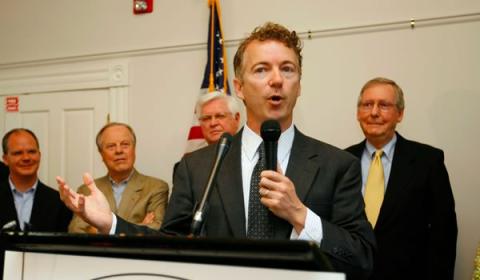tea party movement took shape in 2007. Yet, it is hardly a reflection of the anti-war, anti-deficit, pro-civil liberty message that propelled its early popularity.
During a time of impending recession, a government that had taken us to endless wars on false pretenses, and an unprecedented expansion of government under eight years of “conservative” leadership, the tea party began as a fundraising rally cry for a then relatively unknown dark horse candidate, Representative Ron Paul.
The first “modern day tea party” was held on the anniversary of the original Boston Tea Party, December 16, 2007. In a 24 hour period, in concert with symbolic and peaceful tea party re-enactments across the country, Paul supporters dumped 5.2 million dollars into the long-shot presidential campaign along with fake tea boxes spray painted with slogans like “End the Patriot Act,” “End the War in Iraq,” “End the War on Drugs,” and “End the Fed.” Tweet it: Tweet
There were no anti-gay boxes. No one had a picture of a fetus on their boat. And no one, and I mean no one, had a Sarah Palin sticker on their car.
Not until mid-February of 2009, when Rick Santelli gave a now infamous rant on CNBC, did the more religiously radical and racially declined start waving the “Don’t Tread on Me” flags poached with all the irony that individual liberty and theocracy can muster on the dance floor.
And, as soon as the traditional institutions found an opportunity to fuel the fervor, the tea party boat became a wagon of whiners, propelled by such ironically named organizations as the “American Family Association.” A movement founded on the philosophical principles of Hayek, Bastiat, and Austrian economics became a yelling fest for a less than intellectual conversation about constitutionalism and socialism.
In 2008, some Ron Paul tea partiers set up a website to “Draft” Rand Paul to run against Senate Majority Leader Mitch McConnell’s hand-picked and then Kentucky Secretary of State, Trey Grayson.
Crazy idea, right? Rand Paul initially thought so too. Until 5,000 signed a pledge to support him. Then 10,000. Then 20,000. And by the time the election came around in 2010, there was no stopping what became known in the Ron Paul community as “the Randslide.”
But since 2010, Ron Paulers have had a less than loving relationship with the Senator from Kentucky who continues to proudly serve as a modern-day tea party spokesman. You don’t have to search very far in the “Ron Paul forums” to get a sense of the betrayal many of them feel to the libertarian message that Ron Paul preached and to the humility in which he carried himself.
But, the Rand Paul filibuster must have made many of the old Ron Paulers proud. With humble reverence to the president, Rand Paul spoke eloquently about our right to due process and against unreasonable searches and seizures.
He spoke about our right to privacy without distancing half of the country by substituting biblical phrases for practical discourse. It seemed to be a more eloquent departure from some of his less diplomatic discourse, including his most recent reprimand of the Secretary of State.
Rand Paul’s filibuster may be historic for its own sake and for its impact on a real discussion about privacy and constitutional protections. But, what might be most impressive is that he brought the old Ron Paulers and the new tea partiers together to cheer him on.
The question is, will he use this experience to boost his exposure among activists and reactionaries, or as an opportunity to start leading by example?
